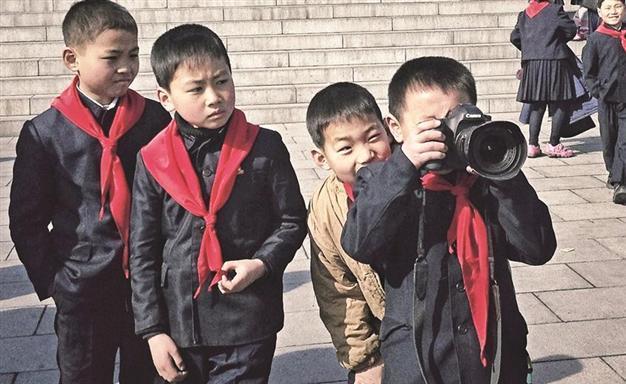N Korea sees unprecedented ‘conversion’ to mobile world
PYONGYANG, North Korea - The Associated Press

In this photo posted to Instagram on Feb. 16 North Korean kids play with an AP photographer’s camera in front of statues of the late leaders Kim Il Sung and Kim Jong Il. AP photo
"Hello world from comms center in (hash)Pyongyang.” That Twitter missive, sent Feb. 25 from Koryolink’s main service center in downtown Pyongyang using my iPhone, marked a milestone for North Korea: It was believed to be the first tweet sent from a cell phone using the country’s new 3G mobile data service.Later, as we were driving through Pyongyang, I used my iPhone to snap a photo of a new roadside banner referring to North Korea’s controversial Feb. 12 nuclear test, while AP’s Chief Asia Photographer David Guttenfelder uploaded an image to Instagram of a tour guide at a mountain temple, geotagged to Pyongyang.
Nothing without permission
Pretty ordinary stuff in the world of social media, but revolutionary for North Korea, a country with intricate rules to stage manage the flow of images and information both inside and beyond its borders. In the past, rules were strict for tourists visiting North Korea. On a bus journey across the Demilitarized Zone into the border city of Kaesong in 2008, we were told: No cellphones, no long camera lenses, no shooting photos without permission. The curtains were drawn to prevent us from looking outside as we drove through the countryside, and through the cracks we could see soldiers stationed along the road with red flags. We were warned they’d raise those flags and stop the bus for inspection if they spotted a camera pointed out the window. As we left North Korea, immigration officials went through our cameras, clicking through the photos to make sure we weren’t taking home any images that were objectionable.
Eventually, Guttenfelder and I settled into a working routine. We’d leave our cell phones at the airport but use locally purchased phones with SIM cards provided by Koryolink, the joint Egyptian-North Korean cell phone venture that established a 3G network in 2008, but without data. We brought iPod Touches and connected to the world, including Twitter, using broadband Internet that may be installed on request at our hotel, which is for international visitors.
We knew in January that change was afoot. “Bring your own phone next time,” a Koryolink saleswoman told me at the airport as we were departing. The next day, the longstanding rule of requiring visitors to relinquish their phones was gone. But we were waiting for the day when Koryolink would begin offering mobile Internet, and hounded the Egyptians posted to North Korea from Orascom Telecom Media and Technology for news. “Soon,” they kept telling us.
Last week, they called with good news: 3G mobile Internet would be available within a week, only for foreigners.
No international internet
Not all North Koreans have local cell phones. Those who do use them to call colleagues to arrange work meetings, phone and text friends to set up dinner dates and ring home to check in on their babies. They snap photos with their phones and swap MP3s. They read North Korean books and the Workers’ Party newspaper, Rodong Sinmun, on their phones.
But they cannot surf the “international” Internet, as they call it. The World Wide Web remains strictly off limits for most North Koreans. North Korean universities have their own fairly sophisticated Intranet system, though the material posted to it is closely vetted by authorities and hews to propaganda.
Students say they can email one another, but they can’t send emails outside the country. Leader Kim Jong-un has pushed science and technology as major policy directives, and we’re starting to see more laptops in North Korean offices. Despite the new construction, gadgets and consumer goods, North Korea is still grappling with grave economic hardship. It’s a society governed by a web of strict rules and regulations, a nation wary of the outside world.
Often, they are images, videos and details that may not make it onto The Associated Press’ products, but provide a behind-the-scenes glimpse of a country largely hidden from view even in our globalized, interconnected world. They help give a sense of the feel, smell and look of the place away from the pomp of the orchestrated events shown by the state media. It is a way for us to share what we see, large and small, during our long stays in a nation off limits to most Western journalists and still largely a mystery, even to us.
















